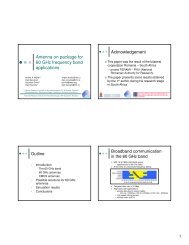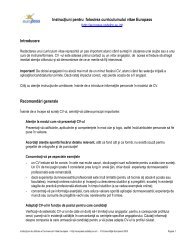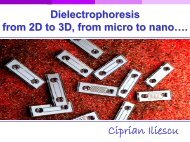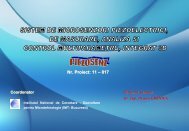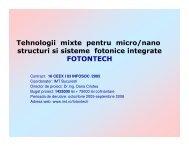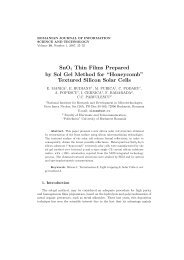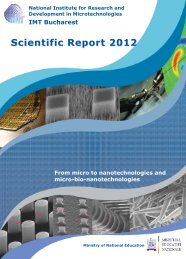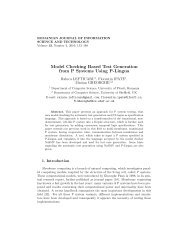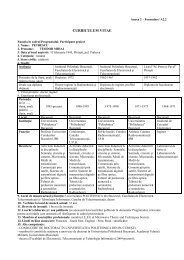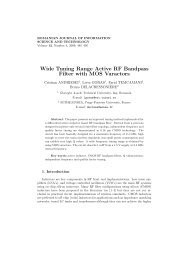MICRO AND NANOTECHNOLOGIES B U L L E T I N - IMT
MICRO AND NANOTECHNOLOGIES B U L L E T I N - IMT
MICRO AND NANOTECHNOLOGIES B U L L E T I N - IMT
Create successful ePaper yourself
Turn your PDF publications into a flip-book with our unique Google optimized e-Paper software.
<strong>MICRO</strong> <strong>AND</strong><strong>NANOTECHNOLOGIES</strong>BULLETINPublished quarterly by: ROMINFOR / Micro and Nano Science and TechnologyN0.1 (pilot issue) NOVEMBER 2000Photo: 38GHz filter structure manufactured onSiO 2 /Si 3 N 4 /SiO 2 membrane on silicon substrate.The miniaturized device was designed, manufacturedand measured by <strong>IMT</strong>-Bucharest, IRST Trento , CNRRome, Univ. Tor Vergata Rome and ICRCOM Limoges(MEMSWAVE European Project).Why "micro and nanoscience andengineering"?Nanoscience and technology are related to physicalstructures with features in the range of nanometres and thecorresponding specific phenomena. In a broad definition,nanotechnology includes all technology associated with either the"top-down" approach of sculpting the desired structure from amacroscopic piece of material, or the "bottom-up" approach ofbuilding a nanostructure atom by atom and molecule by molecule.The nanostructured materials have a huge potential. They allowcreation of completely new materials with desired properties.Microtechnologies are structuring the macroscopicmaterials at the micrometer level. Apart from the microelectronictechnology, which is dedicated to fabricate complex electroniccircuits constructed from electron devices performing their role inmanipulating the electrical signal, micro technologies in generalare able to fabricate physical structures, which are activatedby various forms of energy. Microsensors and microactuatorsare typical examples. But complete systems interacting with theexternal world can be also fabricated. This corresponds to"integration" in one component of various components performingcompletely different tasks, e.g. micro-opto-electrical-mechanicalsystems (MOEMS). Clearly, a unique design process is necessaryand the electrical, optical and mechanical engineering cannotlonger be performed separately.The microsystems do not represent a miniaturisedversion of the larger systems. By scaling down the conventionalsystems, the phenomena are different and the system must be reengineeredor constructed on a completely different principles.A complete new philosophy is brought down by thebiological world. Some materials, structures and (sub)systemsare now inspired from the living organisms. The technicalsystems may become much more efficient in this way. We havealso to consider completely new methods of fabrication andmaintenance (also inspired from living organisms) such as selfassembly,auto-organisation and self-repair.Main topics:• Scientific events preparing the development of theROMINFOR association• Specific activities related to CAS 2000Edited byNational Institute for Research and Development in Microtechnologies,<strong>IMT</strong> Bucharest, www.imt.ro
ROMINFOR AssociationROMINFOR - Micro and nanoscience and technologyA new section of the Romanian Association for Research in IT & Communications (ROMINFOR) wasestablished on November 1st: "Micro and nanoscience and technology". The founders are Romanian researchinstitutes and universities from Bucharest, Iasi,Cluj, Timisoara, Rm.Valcea and Targoviste.The main goals of this section are: to promotethe field among the priorities of the Romanianscientifical research and technologicaldevelopment, to facilitate competitivemultidisciplinary researches and to buildresearch networks at national level and toparticipate in the international researchnetworks with the purpose to build stategicpartnerships with USA and European Unioncountries.The first short term action of the section isalready accomplished by editing this pilotnumber. Soon, a White Book of the field will beelaborated. As medium and long term actions, aseries of volumes wiil be edited, scientific andeducational meetings will be organized and cooperationlinks with foreign professionalassociations will be established.Founder Members of the section "Micro and nanoscience andtechnology" of ROMINFOR:National Institute for Reasearch and Development inMicrotechnologies Bucharest, National Institute for Research andDevelopment in Materials Physics Bucharest, National Institute forResearch and Development in Lasers, Plasma and RadiationsBucharest, Research Centre for Macromolecular Materials andMembranes Bucharest, National Centre for Consulting inEnvironment Protection Bucharest, Research Centre in Theoreticaland Applied Phyisical Chemistry Bucharest, Institute of Biology,Institute for Physical Chemistry, National Institute for Research andDevelopment in Technical Physics Iasi, Institute forMacromolecular Chemistry Iasi, National Institute for Research andDevelopment for Molecular Technology Cluj, Institute forResearches in Condensed Matter Timisoara, National Institute forResearch and Development for Cryogenic and IsotopicTechnologies Rm. Valcea, Institute for Research UniversityPolitechnica Bucharest, University Bucharest, University ValahiaTargoviste.CONTENTS - PILOT NUMBERScientific events paving the way for the establishment of the new association:Presentation of the seminaries in February 2000➤ Micro- and Nanostructures. Possibilities and Perspectives .......................................................................................................... 3➤ Micro- and Nanostructures II ......................................................................................................................................................... 3➤ The Address of Acad. Maya Simionescu at the Seminar “Micro- and Nanostructures. Possibilities and Perspectives”................4➤ The Address of Prof. Lanyi Szabolcz at the Seminar “Micro and Nanotechnologies” .................................................................. 5➤ Towards a National Research and Development Program in Micro- and Nanotechnologies ........................................................6Launch of the multi-disciplinary objectives (description, partners, first results)➤ Micro- and Nanotehnologies in the Research Programme “HORIZON 2000” ................................................................................7Specific activities related to CAS 2000➤ Micro and Nano-technology at CAS 2000 (program from the CAS 2000 proceeding) ...................................................................8➤ Presentation of the Microcosm Technologies Company (outside the program) .............................................................................8➤ Excerpts from the invited paper at CAS'2000: “Micro and nanotechnologies - a Romanian R&D programmeopen to European co-operation” presented by Prof. Lanyi Szabolcs .................................................................................................9➤ NEXUS at CAS 2000: A RoadMap for Microsystems. Speech of EL-Fatatry at communications USC ..................................... 10➤ NEXUS Meetings held in Sinaia (H. C. Petzold Presentation) ......................................................................................................11<strong>MICRO</strong>NANOTECH Presentation (Short description of the program)➤ Sub-programs description .............................................................................................................................................................12Editor <strong>MICRO</strong>- <strong>AND</strong> <strong>NANOTECHNOLOGIES</strong> BULLETINAddress: <strong>IMT</strong>-Bucharest, PO-BOX 38-160, Bucharest, 72225,Tel: +40-1-490.90.40; +40-1-490.84.12; 490.95.53; 490.85.84Fax: +40-1-490.82.38; +40-1-411.46.61http://www.imt.roContact persons:Acad. Dan Dascalu (dascalu@imt.ro)Stefania Rebegea (stefaniar@imt.ro)2
Scientific events paving the way for the establishment of the new associationScientific seminars organized by the National Agency for Science, Technology and Innovation (ANSTI), and theRomanian Academy (Commission for Science and Technology of Microsystems)<strong>MICRO</strong>- <strong>AND</strong> NANOSTRUCTURESPOSSIBILITIES <strong>AND</strong> PERSPECTIVESAula Magna of the Romanian Academy, February 4th, 2000Introductory speeches by the Vice-president of the Romanian Academy andthe President of ANSTI (see the next pages)<strong>MICRO</strong>SYSTEMS, <strong>MICRO</strong>STRUCTURES <strong>AND</strong> NANOSTRUCTURES SCIENCE <strong>AND</strong> TECHNOLOGY Acad. Dan Dascalu, General Manager ofthe National Institute for Research and Development in Microtechnologies - <strong>IMT</strong>-BucharestBIOLOGICAL APPLICATIONS OF <strong>MICRO</strong>STRUCTURES Prof. Dr. Victor A. Voicu c.m. of the Romanian Academy, Manager of the Centre forMedical Military Scientific ResearchesPOSSIBILITIES <strong>AND</strong> PERSPECTIVES OF MATERIALS PHYSICS WITHIN THE <strong>MICRO</strong>- <strong>AND</strong> NANOTECHNOLOGY PROGRAMME Dr. FlorinVasiliu, Scientific Manager of the National Institute for Research and Development in Materials Physics, BucharestNANOSTRUCTURAL MATERIALS <strong>AND</strong> MAGNETIC <strong>MICRO</strong>DEVICES Prof. Dr. Horia Chiriac, General Manager of the National Institute forResearch and Development in Technical Physics - IasiNANOPHASE MATERIALS WITH INDUSTRIAL <strong>AND</strong> ECOLOGIC UTILISATIONS Prof. Dr. Eng. Eugen Pincovschi Politehnica University -Bucharest, Faculty of Industrial Chemistry<strong>MICRO</strong>- <strong>AND</strong> NANOSTRUCTURED FLUID SYSTEMS WITH UTILISATION IN THE PHARMACEUTICAL <strong>AND</strong> COSMETIC FIELD Prof. Dr.Mihaela Olteanu, University of Bucharest, Faculty of Chemistry<strong>MICRO</strong>- <strong>AND</strong> NANOSTRUCTURES IIGeneral Association of Romanian Engineers (AGIR), February 18th, 2000REPORT ON THE PREPARATION OF THE "<strong>MICRO</strong>- <strong>AND</strong> <strong>NANOTECHNOLOGIES</strong>" PROGRAMME Acad. Dan Dascalu, General Manager of theNational Institute for Research and Development in Microtechnologies - <strong>IMT</strong>-Bucharest<strong>MICRO</strong>PROCESSING TECHNOLOGIES OF SNO2 THIN FILMS BASED GAS SENSORS Cornel Cobianu (<strong>IMT</strong>-Bucharest) et al.ELECTRICAL <strong>AND</strong> OPTIC PROPERTIES OF HETEROCYCLIC CONDUCTING POLYMERS WITH APPLICABILITY IN THE FIELD OFCHEMICAL SENSORS R. Turcu (National Institute for Research and Development in Isotopic and Molecular Technologies, Cluj-Napoca) et al.THIN FILMS OF CONJUGATED POLYMERS OBTAINED THROUGH THE REACTIVE VAPOUR DEPOSITION METHOD: AZO-POLYMERSRESULTED FROM AROMATIC DIAZINES Virgil Barboiu (Institute of Macromolecular Chemistry "Petru Poni", Iasi) et al.NANOSTRUCTURES OBTAINED THROUGH SILICON <strong>MICRO</strong>PROCESSING Irina Kleps (<strong>IMT</strong>-Bucharest) et al.POROUS Al 2 O 3 <strong>AND</strong> CARBON NANOSTRUCTURES G. Mihailescu (National Institute for Research and Development in Isotropic and MolecularTechnologies, Cluj-Napoca) et al.EXAMPLES OF LASER <strong>AND</strong> PLASMA OBTAINED <strong>MICRO</strong>STRUCTURES <strong>AND</strong> NANO- <strong>AND</strong> <strong>MICRO</strong>STRUCTURES MATERIALS G. Dinescuand I. Morjan (National Institute of Laser, Plasma and Radiation Physics)<strong>MICRO</strong>ACTUATORS <strong>AND</strong> ELECTROMECHANICAL <strong>MICRO</strong>ACTUATION Mircea Ignat (ICPE-Bucharest)GENETIC ALGORITHMS FOR OPTIMIZATION MATTERS Alexandru Agapie (National Institute for Research and Development inMicrotechnologies, <strong>IMT</strong>-Bucharest) et al.POTENTIAL APPLICATIONS OF <strong>MICRO</strong>- <strong>AND</strong> NANOSTRUCTURES FOR IMPROVING LIFE QUALITY Prof. Dr. Tatiana Oncescu (University ofBucharest, Faculty of Chemistry, Physical Chemistry Department)<strong>MICRO</strong>PHOTONIC DEVICES <strong>AND</strong> CIRCUITS FOR OPTO-ELECTRO-MECHANICAL <strong>MICRO</strong>SYSTEMS Dana Cristea (<strong>IMT</strong>-Bucharest) et al.MAGNETIC MOLECULAR MATERIALS Prof. Dr. Marius Andruh (Faculty of Chemistry, University of Bucharest)MAGNETIC FLUIDS: PREPARATION METHODS, <strong>MICRO</strong>STRUCTURE, PROPERTIES <strong>AND</strong> APPLICATIONS IN TECHNIQUE <strong>AND</strong> BIOLOGYLadislau Vekas (Centre of Fundamental and Advanced Technical Researches - Laboratory of Magnetic Liquids, Timisoara Subsidiary of theRomanian Academy)NEW NANOSTRUCTURED MAGNETIC MATERIALS Wilhelm Kappel (ICPE-Bucharest) et al.CARBONIC <strong>MICRO</strong>- <strong>AND</strong> NANOSTRUCTURES Gabriela Hristea (ICPE-Bucharest) et al.SYNTHESIS HYDROCHEMICAL PROCESSES OF CERAMIC NANOMATERIALS WITH APPLICATIONS IN SENSORS - ACHIVEMENTS <strong>AND</strong>PERSPECTIVES R.R. Piticescu (ICPE Bucharest) et al.3
Scientific events paving the way for the establishment of the new associationThe Scientific Seminar "<strong>MICRO</strong>- <strong>AND</strong> NANOSTRUCTURES -POSSIBILITIES <strong>AND</strong> PERSPECTIVES"The oppening address of ACAD. MAYA SIMIONESCU -vicepresident of the Romanian Academy, Director of the Instituteof Cellular Biology and Pathology“Mr. President, Members of theAcademy, Professors and DistinguishedGuests,The Romanian Academy ispleased to host the first conference onscience and technology of micro - andnanostructures. It is an opportunity forspecialists to share information andknowledge and, together with theresearchers of other fields to estimate thepossibilities and the perspectives of thenew field, of "Nanosciences".The intentions of this seminar are: (1) topresent to the scientific community, animage and a critical overview on thedevelopment of nanosciences in ourcountry and in the world; (2) to identify thepromising areas for further developmentsin the field; (3) to figure out theinterdisciplinary research programs in thefield of nanostructures and (4) to stimulatethe cooperation between the specialistsfrom various fields.The science of nanostructures hasdeveloped as a wide interdisciplinaryresearch area, all over the world especiallyduring the last years when scientistsbecame aware that starting from atomsand the nanoparticles, they can structurematerials with new functions and improvedproperties.You will be listening to a largenumber of specialized papers.I would like to refer to the domain I know alittle better, namely on the promise held bynanomaterials for biomedicine.I think that the medical applications ofnanomaterials will revolutionize themedical sciences, just as 30 years ago, thenew material science, revolutionizedmedicine by introducing the artificialvalves, nylon arteries and artificial joints.The research in Nanomedicine is movingclose to the clinic. Here are a fewexamples: in USA the recent unsuccessfulattempt of applying gene therapy to a 17years old patient, has shocked the medicalscientific community. The young patienthad a very rare genetic defect, making hisbody unable to metabolize ammonium. Hereceived a form of still experimental genetherapy by which small DNA fragmentswere introduced into the cells using viruses(as a Trojan Horse) to repair the absent ordeficient genes. The viral particles weresupposed to insert into the cells the correctDNA fragment, so that in the case of theyoung patient the liver should become ableto process ammonium. However, theparticularly powerful immune reactionresulted in the patient's death. Theresearchers in biomedicine have tried tofind safe alternatives for the gene transportto the human cells. Thus nanotechnologyhas entered the stage.The progress in physicalsciences began to offer alternativesolutions for gene therapy, cancer anddiabetes treatment.The scientists have begun to combine theknowledge in biology and chemistry withthe synthesis and manufacturing of nanoinstrumentsfrom the chemical engineeringand even from microchip industry. Theyhave learned to create tools and materialsat a scale of a thousand millionth of ameter. In this way, structures and toolshave been created that are not bigger thanbiomolecules such as the DNA. Theadvantage of nanostructures is that asnon-biological substances they can beproduced so as the immune response ofthe organism is abolished.Professor James Backer of theUniversity of Michigan has created a newtype of polymer called dendrimer, asynthetic multibranch molecule to whichusing intermediary 'hooks' the DNA can beattached and may be inserted into targetcells. A blast of further studies has shownthat dendrimers can be used in drugtargeting, gene therapy and even in themedical imagery analysis. At present,intense experimental researches are beingperformed on animal models that havegood chances to be extended to the clinicin the future.In addition, the dendrimers havebeen used to create "intelligent bombs" forcancer therapy. They have been designedto detect premalignant or malignantcellular modifications and upon sensing4them to release a substance capable ofkilling the alterred cells. Moreover, they willbe conceived in such a way so as to beable to check whether the alterred cell hasbeen or not destroyed.Researchers in biomedicinehave never been able to actually "play"with these nanoparticles; therefore theyimported techniques and expertise formother domains.The idea of silicon chips, of onlya few hundred nanometers wassuccessfully used experimentally by MauroFerrari at the Ohio University. He usedsilicon nanopackages in which he placedhealthy cells to replace the function ofaffected cells. For instance heencapsulated insulin-producing cells toreplace the altered function of pancreaticcells of a diabetic. The packagescontaining healthy cells can be implantedunder the patient's skin. To avoid theimmune reaction Ferrari manufacturedsilicon capsules outfitted with a membranewith pores at nanometric dimension,sufficiently small so as to avoid antibodiesto enter, and large enough for themolecules synthesized by encapsulatedcells to get out. One of his collaborators,Tejal Desai, is trying to use the samemethod, to replace the function of the braincells affected by Parkinson and Alzheimerdisease. The experimental results areencouraging.In our institute (Institute ofCellular Biology and Pathology), attemptshave been made to use unilamellarliposomes for targeting drugs specificallyto altered cells. We are trying toincorporate an anti-atherosclerosis or ananti-diabetic drug within liposomes that areprovided on their surface with an antibodythat recognizes specific molecules(antigens) present only on altered cellmembranes. It is a small step but theperspectives are great. These are onlyvery few examples of the impact ofnanotechnology in medicine.Prospects are ample in all fieldsand the basic concept is to use theperformances of nanostructures for thebenefit of mankind.Thank you for your attention.
Scientific events paving the way for the establishment of the new associationThe Address of PROF. DR. ENG. LANYI SZABOLCS,President of ANSTI, at the Seminar"<strong>MICRO</strong>- <strong>AND</strong> NANOSTRUCTURES"Aula Magna of the Romanian Academy, Friday, February 4th, 2000“Dearvice-president of the Romanian Academy,dear members of the Academy, dearresearchers, Dear Sirs,I do not want to deliver alecture, but to transmit only a few thoughtswhich have put a mark on us at themoment we have decided that today,here, in the sanctuary of the Romanianscience, in the Assembly Hall of theRomanian Academy, we should initiate ascientific seminar, suggested by thepromoters as a landmark betweenyesterday's and today's science.If it is mentioned intuition is oris not materialized, if we succeed or donot succeed in opening the gate towardsthe science of the third millenium, this liesto the account of the future generation'sconfirmation, but our declared intention isthe proof of our will released to this effect.I took the liberty of mentioningthe third millenium to urge you to take alook, together, at the future.I think, it is really a challenge, toforget about our present-day difficultproblems, and dare together project us inthe future. But I wonder: who is moreentitled to take this leap towards in thefuture, if indeed the servant of scienceand I refer here to our academiccommunity. Who must and can have thepower of coming off the daily lifeclenching, the goals of the society.The scientific research systemstructuring is one of measures belongingto the reform politics in science, resultingin the reorientation of part of researchersin the sense of their subordination to majorobjectives. Actually, I have expressed herethe necessity of coagulating theresearchers around some objectives,defining in fact their inter- andmultidisciplinarity. In other words, with yourpermission, from the above I would haveliked to demonstrate a theorem that interandmultidisciplinary research, as a wayto making the research activity efficient, isa present political objective.Why micro- and nanostructure?Matter micro- and nanostructure and thetechnologies of obtaining micro- andnanostructure equipment represent notonly the domain of the future but also adomain where various branches of sciencejoin in the most spectacular way, a domainconnecting physics with biology, biologywith mathematics, with chemistry, withphysics and all together. The resultant ofthis combination is not only a new science,already called nanoscience, but it also is anew concept about materials andtechnologies, actually a new philosophy,in the sense of going beyondconventionalism towards another worldwhich we do not know to accurately defineit today.What can be moreunconventional than a micromotor startedup by the induced motion of bacteriascourge?!… It is difficult to imagine howfar this science may develop.We thank you for yourpresence and for the help we expect fromyou, so that through the presentations wesubmit to your attention and throughdiscussions we may define together ourpossible contribution, that of the Romanianfuture research to micro- andnanostructure science and technology forthe third millenium.I am convinced that I needn'twish every success to this symposium,because your presence is a pledge ofsuccess.” Thank you (applause).Romanian Academy5
Scientific events paving the way for the establishment of the new associationWorkshop:"TOWARDS A NATIONAL PROGRAMME OF RESEARCH<strong>AND</strong> DEVELOPMENT IN <strong>MICRO</strong> <strong>AND</strong><strong>NANOTECHNOLOGIES</strong>"Part IJune 26 th 2000, University “Politehnica” BucharestPart IIMeasures taken by the Consultative Board of ANSTI fordefining priority issues and the PNCDI (National Research -Development and Innovation Plan) extension with newprograms.- Prof. Dr. Eng. Ion Dumitrache, Rector of the University"Politehnica" Bucharest, introductory address.- Acad. Dan Dascalu, co-ordinator of the working group for the"Micro- and Nanotechnologies" program.- Prof. Dr. Eng. Ecaterina Andronescu, Dean of the Faculty ofIndustrial Chemistry, University "Politehnica" Bucharest.- Dr. Florin Vasiliu, scientific deputy director of INCD MaterialsPhysics.An international dimension of the "micro- andnanotechnologies" program. Access to technology andattractivity of the Romanian offer in international cooperation.- Prof. Dr. Eng. Adrian Rusu, c.m. of the Romanian Academy"The IMPACT project and access to technological facilities inWestern Europe".- Dr. Al. Muller (<strong>IMT</strong>-Bucharest) "The MEMSWAVE project as anexample of the East-West co-operation in high technology".- Dr. eng. Rares Medianu, general manager of INCD - Lasers,Plasma and Radiations Physics - "The COST program ofnanostructured materials".- Dr. Ladislau Vekas "Informing report regarding the meeting ofthe COST Consultative Group For Nanosciences -Nanotechnologies (NanoSTAG)", May, 2000.- Eng. Carmen Moldovan, head of laboratory within <strong>IMT</strong>-Bucharest, "Evolution of the NEXUS excellence network (User-Supplier Clubs)".- Acad. Dan Dascalu "The micro-nano issues in PC 5 andanticipation of future developments. European area of researchand innovation.Towards a new co-operation type within the new program:the resources in Romania must go beyond a critical massand attract a substantial funding from various sources.- acad. Dan Dascalu: Set of proposals (the white book of microandnanotechnologies, interactive databases, laboratorynetworks, training of human, association of research groupsetc.)Debate of proposals”Evolution in the year 2000 of the micro- andnanotechnologies multidisciplinary issues in the "Orizont2000" program.Informing report as concerns the start of researches in thepluridisciplinary objective "New materials and microsystems forlife and environment quality".Launch of competition for the objective "Micro- andnanotechnologies for a competitive and lasting development"- Presentation delivered on the part of the "micro- andnanotechnologies" commission (dr. eng. Nicolae Varachiu,scientific secretary of the "micro- and nanotechnologies"commission).- Presentation delivered on the part of the Consortium that haswon the competition for the first objective (dr. eng Marius Bazu,head of department in <strong>IMT</strong>-Bucharest).- Offer of INCD - Material Physics for the new programme(scientific microsession):"SEMICONDUCTOR QUANTIC STRUCTURES <strong>AND</strong>APPLICATIONS", Dr. M. Lepsa; "ELECTRICAL <strong>AND</strong>LUMINESCENT PROPERTIES OF POROUS SILICONNANOCRYSTALLINE FILMS. ACHIEVEMENTS IN INCDFM",Dr. M. L. Ciurea, M. Draghici, M. Lazar; "NEW PERFORMANTPIEZOCERAMIC MATERIALS WITH A NANOMETRICSTRUCTURE MEANT TO THE FABRICATION OFPIEZOELECTRIC <strong>MICRO</strong>MOTORS <strong>AND</strong> FINE MOVEMENTPIEZOCERAMIC ACTUATORS", Dr. C. Miclea; "MAGNETIC<strong>AND</strong> STRUCTURAL PROPERTIES OF ND2FE14B/ALPHA-FENANOCOMPOSITE MAGNETS"; Dr. M. Valeanu, Dr. C.Bunescu, Dr. A. Jianu, Dr. D. P.Lazar - INCDFM, Dr. Kappel, S.Alexandru - ICPE.Prof. Dr. Eng. Ion Dumitrache, Rector of the University"Politehnica" Bucharest (left)Acad. Dan Dascalu, co-ordinator of the working group forthe "Micro- and Nanotechnologies" program (right)University “Politehnica” BucharestProf. Dr. Eng. Ecaterina Andronescu, Dean of the Faculty ofIndustrial Chemistry, University "Politehnica" Bucharestpresenting an invited paper on Biomaterials.6
Scientific events paving the way for the establishment of the new association<strong>MICRO</strong>- <strong>AND</strong> <strong>NANOTECHNOLOGIES</strong> IN THERESEARCH PROGRAMME "HORIZON 2000"In January 2000, The National Agency for Science, Innovation and Technology (ANSTI) proposed a newmethodology of financing the research projects in the frame of the programme "Horizon 2000". Each comission onspecialties launched the competition for a number of 1-5 general objectives. In the field of micro and nanotechnologies,the auction was organized for two general objectives, both gained by consortia led by the National Institute for Researchand Development in Microtechnologies (<strong>IMT</strong>-Bucharest).In the following, for each general objective, the consortium, the subsidiary objectives and the main projects arepresented.A) "New materials, technologies and microsystemsfor life and environment quality" (started on July 2000)Consortium: National Institute for Research and Development inMicrotechnologies (<strong>IMT</strong>-Bucharest), Research Centre forMacromolecular Materials and Membrans (CCMMM), National Centrefor Consulting in Environment Protection (UPB-CNC) and ResearchCentre in Theoretical and Applied Phyisical Chemistry (UB-CCCFTA)• Natural and syntetical micro and nanostructures (liposoms) withapplications in the directional transport of some active principles(subsidiary objective)"Fluide biocompatible micro and nanostructures for the controlledtransport of active principles" (project)• Techniques and structures for chemical and biologicalmicroprocessing, microseparation, microanalysis and microinstrumentation"Microsystems for fluid microdosing and clinical diagnosis""Microanalysis technics based on silicon integratedmicrocromatography"• Microstructures and microsystems for the study of tissue electricalactivity, physiological activity and for cell manipulation"The multichannel microprobe for recording neural activity""ISFET based sensors for monitoring of the Ca+2, Mg+2, Na+, K+ ionsand ph, in vitro and in vivo"• Nanostructured materials for prosthesing, investigation biomedicalmicrodevices (microelectronics, biosensors) and biometric methods(identification, diagnostic)"Electrodic structures for biosensors for ex vivo application""Cancer finding and therapy using non-conventional microdevices:microsensors and microapplicators"• Computational techniques (molecular calculation included), hardwarearchitectures and microrobotics elements elaborated pn biological(biometric) principles"Biomimetic computational techniques used for the analysis of transportin nanostructured porous media and of molecular magnetism""Architectures and computational techniques for evolutive hardwareused for artificial life"• Composite nanoparticles and nanostructures with selective properties"Functionalized nanoparticles and nanostructures with selectiveproperties used in separations with ecological impact"• Materials and devices for recognizing and eliminating polluting agentsto monitor and protect the environment"Cathalytic membranar microstructures for elminating polluting agents ingazous phase""Nanocomposite materials for microdevices used for eliminatingpolluting agents"• Substance and radiation detectors for controlling environment pollution(detection, monitoring, analysis) and technical and natural environmentimpact on health"Detection and analysis of heavy metals from rivers, lakes and DanubeDelta""Tehnologies for the realization of integrated microstructures forflammable and toxic gas detection"• New materials and technologies for sensors intended to testing foodquality and animal health monitoring"Detection system for polluted media in liquid food""Chemical microsensors arrays for the detection of volatile compoundsfrom degraded foods"B) Micro- and nanotechnologies for competitivity andlasting development (started on September 2000)Consortium: National Institute for Research and Development inMicrotechnologies (<strong>IMT</strong>-Bucharest), National Institute for Research andDevelopment in Materials Physics (INCDFM) and National Institute forResearch and Development in Lasers, Plasma and Radiations(INCDFLPR)• Nanostructured materials with special properties (subsidiaryobjective)"Nanostructured materials and nanosystems based de metals andsemiconductors" (project)"Nano-composite materials based on polymers and organo-metaliccompounds"• Microstructures and nanostructured materials obtained with laser andplasma technologies"New composite ceramic-carbon nanostrured materials""Nanostructured films used in optoelectrinics and microelectronics"• New materials and technologies for electronic, opto-electronic,electrochemical devices, microstructures, microtransducers and electroopto- mechanical microsystems with applications in intelligent fabricationand in power producing, storage, transport and control"Technologies for interferometric and microoptic microstructures(MOEMS) on silicon""Theoretical and experimental studies to developing a technology on thebasis of nano-structurated semiconductor oxide layers for energyconversion and storage devices""Software development for advanced processing of the experimentaldata resulted from different characterization techniques""Development of technologies for photovoltaic devices based onamorphous and crystalline silicon thin-films and on transparent andconducting oxides (TCO) with applications in mecano-opto-electricalmicrosystems.""Technologies and processes for nanostructured functional materialpreparation and applications in electro-opto-mechanical microsystems"• New materials and microtransducers for applications in building as wellas land and air transport"Sensors for the automotive industry"“Behaviour of microsystems in the hostile electrical and mechanoclimaticenvironment of the automotive industry"• Photonic micro- and nanostructures with applications in information andcommunication technology; devices for nuclear radiation detection"Development of semiconductor microcavity-photodetectors forapplications in optical processing and optical communication systems""Development of hybrid technologies for subsystems used in opticalcommunication"• New materials, microstructures and microsystems forcommunications and radiolocation in the field of centimetric, millimetricand submillimeter waves."MEMS technologies, design modelling and new materials forapplications in centimeter, millimeter and submillimeter waves circuits""Dielectric materials with controled temperature coefficient and highpermitivity used in the field of centimetric and millimetric waves”7
Micro and Nanotechnologies activities at CAS 2000Invited PapersCAS 2000"ELECTRICAL PROPERTIES OF NANOCRYISTALLINE POROUS SILICON", M.L.Ciurea, V. Iancu*, National Inst. of Materials Physics, *"Politehnica" Univ., Bucharest,Romania."<strong>MICRO</strong>SYSTEMS IN THE FAR EAST - A REVIEW", A. El-Fatatry, BAE Systems,Advanced Technology Centre, Chelmsford, UK"ADVANCED FUNCTIONAL MATERIALS <strong>AND</strong> THEIR APPLICATIONS", A. Jelenski,Inst. of Electronic Materials Technology (ITME), Warsaw, Poland“<strong>MICRO</strong> <strong>AND</strong> <strong>NANOTECHNOLOGIES</strong> - A ROMANIAN R&D PROGRAMME OPEN TOEUROPEAN COOPERATION”, Lanyi Szabolcz, President of the National Agency forScience, Technology and Innovation, Romania"INNOVATION OF <strong>MICRO</strong>SYSTEMS IN NORWAY", P. Ohlckers1,2, A. Ferber1, Fifty-four point Seven, 2Univ. of Oslo, Norway.Special sessionsFriday, October 13, 14:30 - 16:00, Room "A"Session 13: <strong>MICRO</strong> <strong>AND</strong> <strong>NANOTECHNOLOGIES</strong>Chairman: A.Müller, <strong>IMT</strong>-Bucharest, RomaniaFriday, October 13, 14:30 - 16:00, Room "C"ROUND TABLE: BIOMATERIALSChairperson: E. Andronescu, "Politehnica" University, Bucharest,RomaniaFriday, October 13, 16:30 - 18:30, Room "A"Special NEXUS Session (Invited papers)Opening: A. Jelenski, Chairman of NEXUSPAN,Institute of Electronic Materials Technology (ITME), Warsaw, PolandFriday, October 13, 18:30 - 20:00, Room "C"Special poster presentation of NEXUSPAN National ContactPointsFriday, October 13, 18:30-20:00, Room "B"Session 14: <strong>MICRO</strong> <strong>AND</strong> <strong>NANOTECHNOLOGIES</strong> 2 (Poster)Chairpersons: I. Kleps, <strong>IMT</strong>-Bucharest, F. Craciunoiu, <strong>IMT</strong>-Bucharest,RomaniaROUND TABLE: BIOMATERIALS*Chairperson: E. Andronescu, "Politehnica" Univ., Bucharest, RomaniaSINTERED CERAMICS IN THE CAO - ZRO 2 - AL 2 O 3 - P 2 O 5 SYSTEM, V.Burghelea, A. M. Melinescu, C. Birsan, "Politehnica" Univ., Dept. of Science andEngineering of Oxide Materials, Faculty of Industrial Chemistry, Bucharest, RomaniaHIDROXIAPATITE <strong>AND</strong> ALUMINOUS BIO-COMPOSITE, E. Andronescu, E.Stefan, C. Ghitulica, "Politehnica" Univ., Dept. of Science and Engineering of OxideMaterials, Faculty of Industrial Chemistry, Bucharest, RomaniaBIOVITROCERAMICS USED FOR BONE DEFECTS REPAIR, D. Antonescu, M.Popescu, T. Negreanu, Orthopaedics Clinic Foisor, Bucharest, Romania<strong>MICRO</strong>STRUCTURAL CHARACTERIZATION <strong>AND</strong> MECHANICAL PROPERTIESOF HYDROXY-APATITE THIN FILMS GROWN BY PULSED LASER DEPOSITIONON Ti-ALLOYS SUBSTRATES, V. Nelea, C. Ristoscu, G. Marin, I. N. Mihailescu,*C. Morosanu, INFLPR, *INFM, Bucuresti, Romania<strong>MICRO</strong>ORGANISMS AS BIOMATERIALS USED IN BIOSENSORS FORENVIRONMENTAL MONITORING, I.Ardelean, L. Dumitru, G. Zarnea, Inst. ofBiology, Center of Microbiology, Romanian Academy, Bucharest, RomaniaAPATITIC CERAMIC BIOCOMPOSITES. TESTS "IN VITRO", V. Burghelea 1 , A.Ianculescu 1 , A. Melinescu 1 , V. Laurentiu 2 , C. Tardei 3 , 1 "Politehnica" Univ.,2 ICECHIM SA, 3 ICPE SA, Bucharest, Romania*This is a satellite event to the CAS 2000. The contributions are not included in the Conference ProceedingsAn informal meeting of theNEXUSPAN participantstook place with the occasionof a working lunch planned,on October 14th, in the veryspecial environment of theFoisor Palace. A chamberconcert (Boccherini,Schubert) performed by theGroup CREDO offereddelightful moments to allCAS participants.Sinaia: The Foisor Palace8
The “Micro and Nanotechnologies” programme at CAS 2000Excerpts from the invited paper at CAS'2000:Micro and nanotechnologies - a Romanian R&D programmeopen to European co-operationpresented by Lanyi SzabolcsPresident of the National Agency for Science,Technology and Innovation,Bucharest, Romania……………………………………………A new politics: orientation towards the advanced researchRomania is experiencing considerable difficulties in maintaining its scientific and technological potential. First, difficulties are originated bythe low level of economic development: the economy is weak and cannot sustain directly and indirectly (through the public founding) theresearch and development activities. ………………………………..The message of the president of the Romanian Agency for Science, Technology and Innovation (ANSTI) for the scientific community wasto join the forces in approaching the new challenges of the advanced research.There is no time to complain or regret the past. The best thing to do is to move forward towards the new fields of research, which offerbetter opportunities for the future.The importance of involving the Romania in advanced researchApproaching the new fields of advanced research has advantages. First, it is clear the fact that a new and substantial effort of Romania toinvest in research will show its results in a long period of time (5-10 years). Therefore, orientation towards the advanced research (with apotential which is not yet valorised) makes sense. Secondly, the Romanian research groups involved in advanced research will be moreattractive for the external partners. Of course, a substantial effort in these areas requires important investments, attraction of qualifiedhuman resources.Romanian participation to advanced research: possibilities and opportunities……………………………………………..The initiative of "European Area of Research and Innovation" opens new possibilities of co-operation at the European level. One possibilityis the access to big (and very costly) research facilities. There are also other schemes, partially funded by EU, which already allow theaccess to technological services. This is important for a country like Romania (and for European countries in general), because reducesthe "barrier" of high investments necessary for part of the advanced research.…………………………………………Steps in the evolution of the domain of micro and nanotechnologies in RomaniaThe importance of the domain of microtechnologies was recognised in Romaniaas early as 1991, when a Centre of Microtechnology was set up by the Ministryof Education and Research. This Centre became in 1993 the Institute ofMicrotechnology (<strong>IMT</strong>), supervised by the Ministry of Research and Technology.In the same year (1993), a special section of "microtechnologies" was introducedalong with Information and Communication Technologies in the National Plan forResearch and Development………. The national R&D programme "Horizon2000", launched in 1996 contains a separate section titled "microtechnologies"(and including nanotechnologies). ……………….In a special session of CAS 2000,Microcosm Technologies waspresented by Dirk Backhaus,Marketing / Business DevelopmentManager CEA rapid development of the domain policy took place this year. The commissionof "microtechnologies" of the Consultative Board of the National Agency forScience, Technology and Innovation (ANSTI) was reorganised as a multidisciplinarycommission of "micro and nanotechnologies". Scientific seminars of"Micro and nanostructures" organised by ANSTI and the Romanian Academytook place in February and June 2000. After and extensive debate of thescientific community, the competition for the financing of two complex multidisciplinaryobjectives (2000-2002) was launched. The two objectives, alreadyunder execution are: a) New materials, technologies and microsystems for thequality of life and of the environment; b) Micro and nanotechnologies forcompetitivity and sustainable growth.In June 2000, the Consultative Board of ANSTI decided to launch newprogrammes of the National Plan for Research, Development and Innovation(PNCDI). The new programmes are defining the priorities of research in thiscountry. One of these programmes (<strong>MICRO</strong>NANOTECH) is devoted to "Microand Nanotechnologies"………………………..9Microcosm Technologies, Inc. provides a unique end-to-enddevelopment environment for successful creation of microelectro-mechanicalsystems (MEMS) and fluid molecularsystems. They currently employ 105 people worldwide. Theirsoftware, professional services, and manufacturingpartnerships facilitate the creation of MEMS solutions thatare revolutionizing the full spectrum of industries, and arehaving explosive impact on telecommunications and biotechnology.The software is scalable to the developmentenvironment. Developers can affordably license multipleseats of layout and/or solid modeling tools for the designengineers' desktops, and export designs to a companycentral point (or to Microcosm's Professional Services staff)to perform physics analysis using the Microcosm tools ortools such as ANSYS. The design kits enable virtualprototyping that eliminates costly product iterations.Recently, <strong>IMT</strong>-Bucharest acquired from MicrocosmTechnologies a software for MEMS development.
NEXUS at CAS 2000NEXUS 2000: A RoadMap for MicrosystemsAyman El Fatatry, BAESYSTEMS - Advanced Technology Centre, NEXUS Vice ChairmanNEXUS, the European network of excellencein microsystems, is about to embark on amajor transition of becoming an Associationrepresenting members from across theworld. NEXUS started life, in 1992, as anacademically-driven network representingthe interests of various researchers workingon micro-fabrication and micromachiningtechniques. This specific phase of theAyman El Fatatry Network was particularly useful in forming thebasis of a wider consortium addressing the more general topic ofmicrosystems. During 1995, NEXUS II amalgamated the EasternEuropean activities in microtechnologies under the banner ofNEXUSPAN. In addition, representation on the Executive Board shiftedfrom an academically strong group to that of an industrially-driven one.This shift was deemed necessary by both the NEXUS members and theEuropean Commission in order to speed the process of MSTGaetan Menozzi, MEMSCAP, NEXUS Chairmantechnology exploitation and transfer.The strength of this industrial presence was consolidated in 1997 withthe formation of NEXUS III. This phase of NEXUS also saw theintroduction of the User-SupplierClubs, the beginning of the marketanalysis investigation and the start of benchmarking visits outside theEuropean Union. NEXUS IV, was launched in 1998 with a strong baseof User-Supplier-Clubs led by industry. In essence, NEXUS transferredfrom an academic network to an applications / industrially - drivennetwork of MST technology users and suppliers. The presence ofacademia was consolidated within the User-Supplier-Clubs, thereby,maintaining the important role of academia and research within thisnetwork. Basically, NEXUS has, over the past 8 years, seen its role shiftfrom an academicallydriven network into an industrially-driven one. Inaddition, the size of the network increased substantially to its currentlevel of almost 450 members representing all of the European nations.The natural progression for this network is to expand on a global basis.Over these years, NEXUS has been instrumental in promotingmicrosystems across Europe through a number of concerted tasks. Themain success, however, has been achieved through the activities of theUser-Supplier-Clubs (USCs). These unique groups have provided thebasis of most of the NEXUS deliverables in terms of market forecasts,technology roadmaps and international benchmarking information.To date, NEXUS has been supported, primarily, by the European Union(ESPRIT / IST - DG XIII). The European Union support averaged atapproximately 1 M Euros per year. This level of funding has been (andcontinues to be) utilised to support the main activities and disseminationfunctions of this Network.The increasing level of support has prompted the Executive Board ofNEXUS and the European Union to consider alternative routes foroperating such an organisation. The main driving factors were:➢ The network has been operational since 1991 and has set-up astable infrastructure which should be self sustaining.➢ Most members have, by now, accepted the benefits offered them byNEXUS.➢ The European Union has fulfilled its role in setting up the necessaryinfrastructure.for such a network as would be required for a new technology.➢ The operation of the Network's office has been stream-lined and themanagement of the Network has become effective and efficient overthe years.➢ Outputs from the NEXUS organisation have attracted significantinterest from both within and without the European Community.Given these encouraging signs, the NEXUS Executive Board membershave chosen to transfer the status of this organisation from that of aNetwork to that of a legal, nonprofit, Association. Such an Associationwill be registered as an official body and managed by a professionallegal entity.The transition of NEXUS from a fully-supported, European Union,network to that of a fully-sponsored, independent, Association will be agradual one. This gradual transition will be initiated during the first 12months of the current phase of NEXUS, whereby, the infrastructure andfoundation of the Association will be set and the mechanisms ofsponsorship agreed by all the sponsoring members.THE NEXUS <strong>MICRO</strong>SYSTEMS ASSOCIATION (NMA) - The BeneftsThe NMA will undertake the co-ordination of a number of core activitiesand tasks aimed at benefiting either the specific or general needs of itsmembers. Examples of these benefits include:• Members will have the option ofjoining established User-Supplier-Clubs, thereby, addressing applications which are specific and ofrelevance to their businesses.• Members will be offered the opportunity and infrastructure to set-upnew UserSupplier-Clubs of choice.• In this context, the NMA offers the appropriate infrastructure and theunique opportunity for members to meet new partners through the User-Supplier-Clubs.• The NMA Steering Committee will sponsor specific tasks undertakenby members including the generation of Technology Roadmaps.• Through the User-Supplier-Clubs, all proactive members will be ableto participate in the generation of and /or access to targeted informationincluding the technology roadmaps relating to microsystemsapplications and developments• The NMA Steering Committee will co-ordinate support and facilitatemarket10investigation activities undertaken by members on its behalf.• This information on market opportunities as well as market analysisreports will be made available, at preferential rates, to all of the NMAmembers.• All NMA members will receive regular information on European andworld-wide developments, events and information relating tomicrosystems.• Through the NMA, members will be in a better position to influence thescope of European Research Programmes.• The NMA office will make available, to all members, a comprehensivelist of contacts including a database of world-wide microsystemscapabilities.• As an influential body, the NMA will represent members views onStandards both at National and International levels.• All members of the NMA will receive regular bulletins, news-letters andtrade journals such as MST-news.• Through participation at conferences, exhibitions and seminar, theNMA will provide opportunities for members to publicise their interestsand businesses.In essence, NEXUS is currently an influential body representing an important network of European organisations with interests in microsystemstechnologies. NEXUS, as an Association, will exploit this strength by repositioning this network on a world-wide arena. European organisations havean excellent opportunity to become world players in this field of technology. The NEXUS Microsystems Association will be instrumental in securingthis goal.
Within the framework of the annualInternational Semiconductor ConferenceCAS'2000, held in Sinaia (Romania), NEXUSsponsored and organised various sessionsand meetings which aimed at furtherenhancing the collaboration betweenMST groups in Central / Eastern Europeand Western Europe. These events werehosted by Prof. Dan Dascalu, GeneralChairman of CAS'2000, head of the NationalInstitute for R&D in Microtechnolo-gies (<strong>IMT</strong>)in Bucharest, and member of the NEXUSPANSteering Committee.Friday, 13 October 2000 (the last day of theconference), was completely de-voted toMicro- and Nanotechnologies, with numerousinvited talks given by international speakersand two large poster sessions. During themorning ses-sion, among others, twomembers of the NEXUS Executive Board (EB)gave invitedpresentations: A.El-Fatatry (BAESYSTEMS, UK)presented aperspec-tive on"Microsystems inthe Far East"based on theNEXUS Far East mission, while A. Jelenski(ITME, Poland) presented a paper on"Advanced Functional Materials and theirApplications". During the afternoon, a SpecialNEXUS Ses-sion provided a comprehensiveoverview of current and planned NEXUSactivi-ties: A. El-Fatatry, Vice Chairman ofNEXUS, explained the way "Towards aMicrosystems Association" and,subsequently, the "NEXUS Roadmap for Microsystems".Following, the approach of theNEXUS report about CAS 2000NEXUS meetings held in SinaiaNEXUS User-Supplier Clubs was presentedand illustrated by the example of 3 club:"Aerospace & Geophysics" (presented by A.Jelenski on behalf of J. Suski,"Telecommunication" (A. El-Fatatry), and"CAD" (P. Salomon). Finally, A.Jelenskipresented plans to establish a new User-Supplier Club on "Functional Materials forMST". These pres-entations were open to allCAS participants and were attended, in spiteof the fact that it was the last day of theconference, by about 40 participants. Thepresentations were followed by a specialposter session organised by the at-tendingNational Contact Points, representingNEXUS(PAN) within nine Central/EastEuropean (CEE) countries The NCPspresented their, impressive, MST related R&Dresearch results. In the evening, a specialNEXUS cocktail party was held as anoccasion to continue discussions in aninformal atmos-phere.On Saturday morning (October 14), ameeting was held (attended by about 25people) which was devoted to the exchange ofviews between the attending National ContactPoints (NCPs, from Belarus, Hungary,Lithuania, Moldova, Poland, Romania,Russia, Slovakia,and Ukraine), theNEXUSPANS t e e r i n gCommittee, and theNEXUS EB. Itstarted by apresentation ofH.-C. Petzold,summarising theachievements ofNEXUSPAN over the past years, followed byshort presentations of the attending NCPs onwhat they did in that role in the past, and howthey see NEXUS in the future.In the concluding Round Table discussion,chaired by A. El-Fatatry, some key points thatare considered crucial for the futureinvolvement of Central/East Europeanmember organisations in NEXUS wereelaborated:The CEE attendees expressed their concernsover the lack of funds e.g. to supportattendance at conferences, exchange visitsNANOMATERIALS AT ROCAM’2000 - CONFERENCE ON ADVANCED MATERIALSOctober 23th-25th, Romanian AcademySESSIONS ON NANOMATERIALS1. Poster session"The Prediction of Band Gap Value in Porous Silicon Through the Modeling of PoreFormation", A. Dafinei, D. Ionita (University Bucharest)"Metal Structures in Quartz Crystals; Fractal Properties", I.Enculescu, BrandusaIliescu, I.Istrate (INCDFM)"Absorption and Emission of Ag Aggregate Centers in KCl Crystals", MonicaEnculescu, V. Topa (INCDFM)"Annealing influence on magnetic behaviour of nanocrystalline Fe-Hf-B basedribbons", H. Chiriac, C. Hison, M.Neagu (INCDFT Iasi)"Recrystallisation Phenomena During High Energy Ball Milling", Gabriela Nicoara,Nicoleta Popescu-Pogrion, Victoria Husar (INCDFM)"Metal Structures in Quartz Crystals; Chemical Processes", Ioana Pera,I.Enculescu, Gabriela Alexe, Brandusa Iliescu, S.Polosan (INCDFM)"Properties of metal clusters embedded in KCl matrix", S. Polosan, Elena Apostol,V. Topa (INCDFM)"Methods for nanoparticle size determination", Lucia Meahcov (MATPUR SA)"Magnetic and structural properties of g Fe2O3 nanoparticles dispersed in a silicamatrix", I.Hrianca, C. Caizer, C. Savii, M.Popovici (Romanian Academy)11etc. It was emphasised, however, that fundinglimitations have been imposed across all ofthe NEXUS activities and not just those of theCEE/NEXUSPAN. On the other hand, the EBrepresentatives confirmed the availability of abudget, under NEXUS-2000, dedicated to theintegration of NEXUSPAN members within thepan-European MST community. These fundsare, however, spread across all of the NEXUSactivities that have been agreed with the EU.The NEXUSPAN members, along with all theother NEXUS members, are able to accessthese funds through active participation inthese tasks.It was agreed that the main aim ofNEXUSPAN is to disseminate information topromote the activities in Eastern Europe, inorder to assist in the exploita-tion of the R&Dundertaken by the NEXUSPAN members.One route for dis-semination is through theUSCs. The NCPs were, therefore,encouraged to participate within the USCs,either by attending the meetings or throughelectronic means, and to encourage, in turn,their own national MST com-munity to activelyparticipate in the USCs and the tasks ofNEXUS.The meeting was found to be constructive,and specific actions decided at the meetingare expected to help in enhancing the processof interaction and dis-semination betweenNEXUS members in the East and West.The eventful days in Sinaia were concludedby an excellent dinner for the invited speakersand NCPs at the beautiful Foisor Castle, aformer residence of the Romanian King, todayused by the President of the RomanianAcademy of Sciences for receptions. As acultural highlight, a chamber music concertwas held, exclusively for the NEXUS guests.Details of the programme at photos takenduring the various sessions can be found atthe conference website http://www.imt.ro/cas/On behalf of all the participants, the authorswould like to thank Prof. Dascalu and histeam, especially Mrs. Doina Vancu, for theexcellent organisation of the various NEXUSevents and the warm hospitality that theyenjoyed during their stay in Romania.Hans-Christian PetzoldAyman El-Fatatry2. Oral session"Structural and magnetic investigation of mechanically alloyed Fe 90 M 7 B 3 (M=Nb,Zr, Hf) powders", H. Chiriac, A.E.Morga, M.Urse, C.Hison (INCDFT Iasi)"Anodic Porous Aluminium oxide filled by various metals (Co, Cu, Ni). An X-raydiffraction Study", E. Indrea, Stela Pruneanu, G. Mihailescu (ITIM Cluj)"Sol-Gel Monocomponent Nano-Sized Oxide Powders", Maria Crisan, A. Jitianu, D.Crisan, Marina Balasoiu, N. Dragan, Maria Zaharescu (Inst. Chimie-Fizicai)"TiO2-Based Nanostructures Sol-Gel coatings for Water Treatment", MariaZaharescu, C. Trapalis, Maria Crisan, Alexandra Szatvanyi, Mariuca Gartner (Inst.Chimie-Fizicai)"Magnetic interaction and magnetoresistance in nanoscaled melt-spun materials",Bogdan IDZIKOWSKY (Polish Academy of Science)"Transition Metal Clusters in a C60 Matrix", R. Manaila, D. Macovei, R. Popescu,C. Giusca, A. Devenyi (INCDFM)"Gold Nanoclusters Obtained in KCl Crystals", V. Topa, E. Apostol, M. Enculescu,E. Vasile (INCDFM)
<strong>MICRO</strong>NANOTECH in the National R&D PlanThe programme "<strong>MICRO</strong>NANOTECH" emerged from the researches performed in the frame of the programme "Horizon 2000", where amultidisciplinary approach was needed. Especially, the two general objectives promoted in year 2000 about micro and nanotechnologies ("Newmaterials, technologies and microsystems for life and environment quality" and "Micro- and nanotechnologies for competitivity and lastingdevelopment") led to the involvement of specialists from various fields: microelectronics, physics, biology, chemistry, mathematics, etc. It is the aimof the programme "<strong>MICRO</strong>NANOTECH" to put together the effort of all these specialists, trying to build a coherent development of this new andpromising field, micro and nanotechnology, already considered by USA and European countries as a scientific priority for the near future (see theAmerican Initiative on Nanotechnologies, started in January 2000!). This programme will allow to have under the same cover all the researchactivities on micro and nanotechnologies: basic researches, pre-competitive researches, competitive researches and technology transfer.Elaborating new materials, proceses, technologies, simulation and characterization techniques, micro and nanostructures, integrated (sub)systemsand microsystems will be the main purpose of the programme "<strong>MICRO</strong>NANOTECH".Also, this new programme is interconnected with other new programmes, such as "New materials" or "Life and Health". The new programme of"micro and nanotechnologies" (<strong>MICRO</strong>NANOTECH) was approved as part of an extension of the National Plan for Research, Development andInnovation (PNCDI), by the Decision No. 1013 of the Romanian Government (26 th October 2000).Subprograms of the <strong>MICRO</strong>NANOTECH programMNT 1 Microelectronics, power integrated electronics, optoelectronics, microwaves· Specialized electronic circuits integrated in the microelectronic technology· Devices and modules for power control and conversion (power semiconductor devices, solar cells,electrochemical microbatteries, consumption monitoring systems included)· Microelectronic, microphotonic and microwave integrated subsystems· Optoelectronic and microwave devices necessary for information processing and transmission· Photonic micro- and nanostructures with applications in communications· New materials, microstructures and microsystems for communications and radiolocation in therange centimetric, millimetric and submillimetric waves· Substance and radiation detectors for environment pollution controlMNT 2 Electro-Opto-Mechanical Microstructures and Microsystems· New materials and technologies for electro-opto-mechanical microstructures and microsystemswith applications in intelligent fabrication· Microstructures and microsystems used in power producing, storing transport and control· Microstructures, microtransducers and microsystems with applications in communications,information processing and aerospace applications· Microstructures and microsystems for chemical and biological microprocessing, microseparation,microanalysis and microinstrumentation· Sensors for testing food quality and animal health monitoringMNT 3 Microtransducers and intelligent materials· Microtransducers (sensors and miniaturized and integrated driving elements): materials,demonstrating technologies with applications in industry, agriculture, zootechny, constructions andin land and air transport· Intelligent microsystems (intelligent sensors and sensor matrices included) with applications inindustry, agriculture, zootechny, constructions as well as land and air transport· Materials, devices and microsystems of recognizing and eliminating the pollutant agents forenvironment monitoring and protectionMNT 4 Systems and Structures for Interfacing Living Matter and Biomimetics· Microdevices and microsystems of biomedical investigation (microelectrodes, biosensors,microfluidics elements etc.) for cell and genetic material manipulation and study, included· Computational technics (molecular computation, included), hardware architectures, microroboticsmicrosystems and elements conceived on biological (biomimetic) principlesMNT 5 Nanostructures and Nanostructured Materials· Nanostructured materials for biomedical applications (prosthetic biomaterials included)· Composite nanoparticles and nanostructures with selective properties· Nanostructures and nanostructured materials for applications in electronics, electrotechnics,mechanics, metallurgy etc.· Microstructures and nanostructured materials obtained with laser and plasma technologies(materials with a large specific surface, over 50m2/g; structures with increased chemical reactivesurfaces)· Nanostructured materials with special properties (soft and hard magnetic nanomaterials,icosahedral nanostructured alloys with high micromechanical characteristics, carbonnanostructures: conducting polymers/carbon nanostructures based nanocomposites, nanosystemsmetal - C60 fulerene with charge transfer at interfaces, adsorption processes on micro- andnanorugged structures used in the sensor technology, nanocrystalline Si and Si/C basednanostructured materials with optimum properties for sensor applications, pattern memory materialsfor actuators and micropumps, magnetic nanostructures with a huge and colossalmagnetoresistance, nanocomposite materials)MNT 6 Support Activities· Centres and activities of training through research and technological support in microsystems,microelectronics and nanostructured materials· Networks of research laboratories12MME 2002Micromechanics EuropeOctober 6-8, 2002Sinaia, RomaniaOn the 2 nd October2000 at the Upsala UniversityAuditorium, the MicromechanicsEurope Workshop SteeringCommittee has decided withunanimous vote that the 13 thEdition of this Conference will takeplace between 6-8 October 2002 atSinaia, RomaniaAfter Twente 1989,Berlin 1990, Leuven 1992,Neuchatel 1993, Pisa 1994,Copenhagen 1995, Barcelona1997, Ulvïk 1998, Paris 1999,Uppsala 2000, Cork 2001, theprestigious conference will be heldfor the first time in Eastern Europe.This is the result of the extremlyactive and valuable presence of the<strong>IMT</strong>-Bucharest contributions at thepreviously editions of thisconference.CAS 2001INTERNATIONALSEMICONDUCTORCONFERENCE24th EditionOctober 9-13, 2001, Sinaia,RomaniaThe International SemiconductorConference (CAS) is a yearly eventorganized by the National Institutefor Research and Developmentin Microtechnologies (<strong>IMT</strong>-Bucharest). The Conference is cosponsoredby IEEE ElectronDevices Society, RomanianNational Agency for Science,Technology and Innovation(ANSTI), IEEE-Romania Section,Electron Devices Chapter. Theevent takes under the aegis of theRomanian Academy and theElectrochemical Society, Inc.Deadlines:- 15 th April, 2001: Submission ofthe contributed and invited papers;- 15 th June, 2001: Notification ofthe final acceptance of contributedpapers .<strong>IMT</strong>-Bucharest - CAS Office32B Erou Iancu Nicolae Str., 72996Bucharest, RomaniaMailing address: PO Box: 38-160,72225 - Bucharest RomaniaPhone: +40-1-490.82.36 Fax:+40-1-490.82.38 (+40-1-411.46.61)E-mail: cas@imt.rohttp://www.imt.ro/CAS



